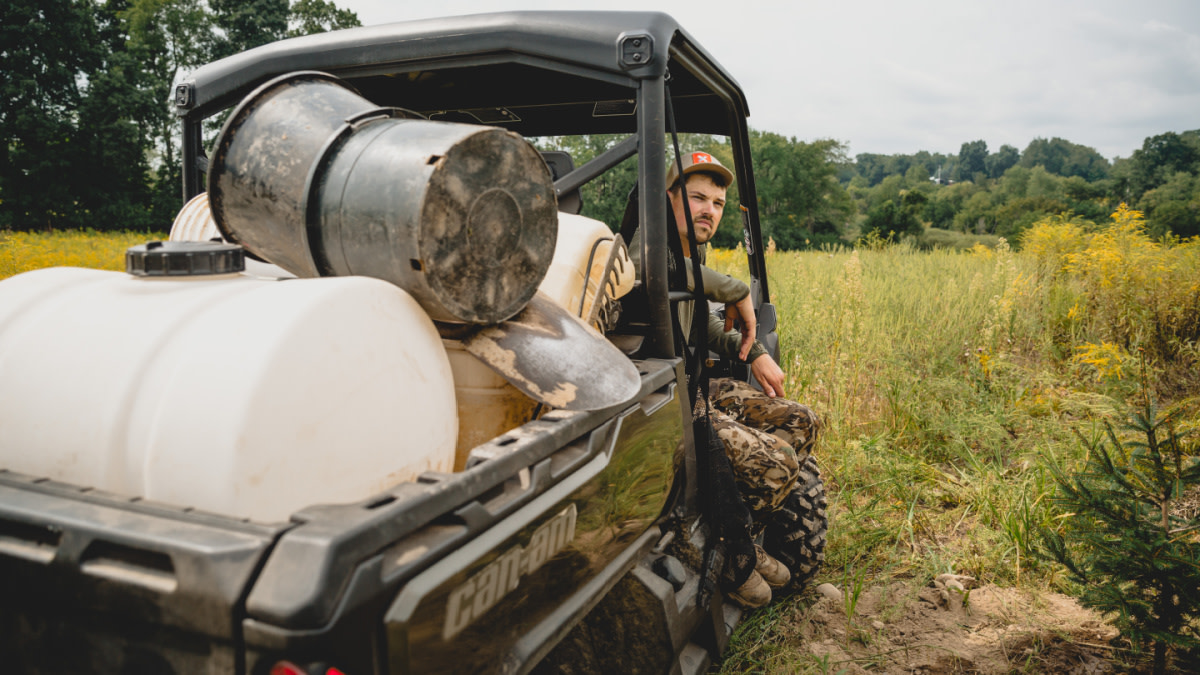
It’s routinely preached that deer need three things to flourish: food, cover, and water.
If this trifecta of whitetail necessities were a rock band, food sources would sing lead vocals, cover would play the guitar, and water would pluck the bass—quiet, omnipresent in the background, and rarely getting the attention it deserves.
While often overshadowed by its flashier bandmates, water can make a world of difference if it is present in the right places. Fortunately, if you own or manage property, it’s not too hard to make that happen.
Why? Plenty of hunters think that much of a whitetail’s water needs are fulfilled through eating vegetation. While that is true, it would be a mistake to ignore the impact standing water can have on deer behavior.
“Deer can get all the water they need from eating plants, BUT they won’t turn down a drink of water if it’s convenient,” writes Tom Indrebo in his book Growing & Hunting Quality Bucks.
If you can create a convenient water source for deer and place it in an area that is strategically useful from a hunting standpoint, you’ve got a tool that can help you on any day of the hunting season. A small pond will attract deer, even if it’s not as sexy as a lush food source. For some hunters, like Wired to Hunt’s Tony Peterson, ponds are a favorite spot to ambush public land whitetails in early and late season while everyone else is sitting on a field edge.
But maybe more importantly, a strategically placed pond can both bring deer into a range and position ideal for a shot and keep them occupied while you maneuver. This is no small thing. On top of all that, in certain situations like hot September afternoons or in the middle of an all-day rut marathon, water sources actually can out-perform food.
Location The first step in adding the ideal water source is determining the right location. Likely the greatest benefit of adding water yourself is the fact that you can be strategic with where this attractant is placed. Location will make all the difference in how useful water will be to your hunting.
First, you ideally want to place your small pond near a preferred deer travel corridor. Getting a buck to trek significantly out of his way to visit water is a big ask, but getting him to swing by along his normal route is much more likely.
“Never forget that whitetails are opportunists, which makes convenience a key factor in their diet,” Indrebo said. “As long as they only have to walk a few steps for a drink, they’ll go for a short, warm, drink of brown water.”
The next factor to keep in mind is how to ensure that deer feel safe when visiting your future pond. In a recent Wired to Hunt how-to video, Peterson spoke about the importance of keying in on water sources that provide a sense of security for deer. This might be the factor that will most influence if deer will visit it in daylight.
“What I want to see is small water in the cover,” Peterson said. “The deer don’t care what quality of water it is. They care about if they’re going to put themselves in danger if they get a drink.”
If you want a pond that is attractive in daylight, make sure you’re placing it in an area of relatively dense vegetation where bucks naturally feel comfortable during the day.
“If a pond meets their security requirements, deer will visit it often, making it a place you’ll want to hang around during archery season,” Indrebo said.
Finally, think about how your water location will set up for a hunt. Can you access it without spooking deer? Will the prevailing winds allow you to hunt nearby? Is there a suitable tree that can get you in range of the pond and trails while also providing adequate cover? Check these final boxes and you’re ready to start digging.
Construction While there are many ways to get water in the ground, my budget and equipment availability has always forced me into the easiest of options—and any hunter can replicate it.
I picked up this ridiculously simple idea several years ago from Whitetail Habitat Solutions founder, Jeff Sturgis. I’ve implemented it on my own properties in the years since. The idea is to create a small water hole by simply burying a plastic or rubberized stock tank in the ground.
A tank such as this, something even as small as 100 gallons, costs somewhere around $60 and can be bought from most any farm supply store. The process from there is straightforward.
Dig a hole large enough to bury the tank up to its lip and try to place it in a low spot where run-off can accumulate. Next, bring in water with a truck or ATV to fill it up. Finally, place a small stick in the water that extends above the lip so that any mouse or small critter that falls in has an escape route. Depending on your location and the amount of sunlight received, you’ll likely need to refill the tank several times a year. But that’s all there is to it.
Keep it Simple A small stock tank pond like this might sound insignificant, but don’t be fooled by the lack of flash. In the right location, a small standing water source can be just enough to tip the scales in your favor. It benefits you every time you hunt it, and it benefits the herd every other day you’re not there.
Feature image via Captured Creative.






Conversation